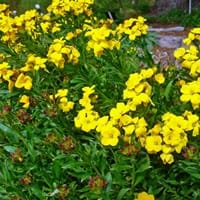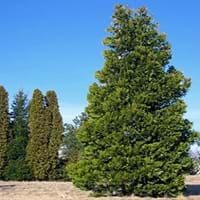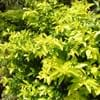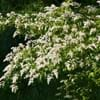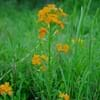Life Span
Annual and Perennial
Annual and Perennial
Type
Tender Perennial
Tree
Origin
Southern Europe, Mediterranean
Western United States, California, Mexico
Types
Not Available
Not Available
Habitat
gardens, Grassland, Prairies
low mountains, Mountain tops, Subtropical climates, Temperate Regions
USDA Hardiness Zone
7-9
5-8
Sunset Zone
4, 5, 6, 14, 15, 16, 17, 18, 19, 20, 21, 22, 23, 24
1a, 1b, 2a, 2b, 3a, 3b, 4, 5, 6, 7, 8, 9, 10, 11, 12, 14, 15, 16, 17, 18, 19, 20, 21, 22, 23, 24
Habit
Mat-forming
Upright/Erect
Flower Color
Blue, Lavender
Non Flowering Plant
Flower Color Modifier
Bicolor
Bicolor
Fruit Color
Green
Sandy Brown
Leaf Color in Spring
Gray Green
Green
Leaf Color in Summer
Gray Green
Green
Leaf Color in Fall
Gray Green
Green
Leaf Color in Winter
Light Green
Green
Leaf Shape
Linear
Pinnate
Plant Season
Spring, Summer, Fall, Winter
Spring, Summer, Fall, Winter
Sunlight
Full Sun, Partial Sun
Full Sun, Partial Sun
Type of Soil
Loam, Sand
Loam, Sand
The pH of Soil
Neutral, Alkaline
Acidic, Neutral
Soil Drainage
Well drained
Well drained
Bloom Time
Spring, Late Spring, Early Summer, Summer, Late Summer, Early Fall
Not Available
Tolerances
Drought
Drought
Where to Plant?
Container, Ground, Pot
Ground
How to Plant?
Seedlings, Stem Cutting
Stem Planting
Plant Maintenance
Medium
Medium
Watering Requirements
Allow soil to be completely dry in between waterings, Water Deeply, Water less during winter
Needs less watering, Water occasionally
In Summer
Lots of watering
Lots of watering
In Spring
Moderate
Moderate
In Winter
Average Water
Average Water
Soil pH
Neutral, Alkaline
Acidic, Neutral
Soil Type
Loam, Sand
Loam, Sand
Soil Drainage Capacity
Well drained
Well drained
Sun Exposure
Full Sun, Partial Sun
Full Sun, Partial Sun
Pruning
Cut or pinch the stems, Do not prune during shooting season, Prune if you want to improve plant shape, Prune prior to new growth, Remove deadheads
Prune if you want to improve plant shape, Remove damaged leaves, Remove dead branches, Remove dead leaves
Fertilizers
No fertilizers needed
No fertilizers needed
Pests and Diseases
fungus, Insects, Red blotch
Insects
Plant Tolerance
Drought
Drought
Flower Petal Number
Single
Not Available
Fragrant Bark/Stem
No
Yes
Foliage Texture
Fine
Medium
Foliage Sheen
Matte
Matte
Attracts
Bees, Birds, Butterflies
Birds
Allergy
Skin irritation
no allergic reactions
Aesthetic Uses
Beautification, Showy Purposes
Showy Purposes
Beauty Benefits
Not Available
Not Available
Environmental Uses
Air purification
Air purification
Medicinal Uses
No Medicinal Use
Stomach pain
Part of Plant Used
Whole plant
Bark, Leaves
Other Uses
Showy Purposes
Making Perfumes, Used in pencil industry
Used As Indoor Plant
No
No
Used As Outdoor Plant
Yes
Yes
Garden Design
Alpine, Container, Edging, Foundation, Groundcover, Mixed Border, Rock Garden / Wall
Screening / Wind Break, Shade Trees, Street Trees
Botanical Name
Erysimum cheiri
CALOCEDRUS decurrens
Common Name
Wallflower
Incense Cedar
In Hindi
पीला Wallflower
Incense Cedar
In German
Yellow Wallflower
Zeder
In French
Yellow Wallflower
Encens Cedar
In Spanish
alhelí amarillo
cedro de incienso
In Greek
κίτρινο Wallflower
θυμίαμα Κέδρος
In Portuguese
Wallflower amarelo
cedro de incenso
In Polish
Żółty Wallflower
kadzidło Cedar
In Latin
Crocus Wallflower
incensum Cedar
Phylum
Magnoliophyta
Tracheophyta
Class
Magnoliopsida
Pinopsida
Order
Brassicales
Pinales
Family
Brassicaceae
Cupressaceae
Genus
Erysimum
Calocedrus
Clade
Angiosperms, Eudicots, Rosids
Not Available
Tribe
Not Available
Not Available
Subfamily
Not Available
Not Available
Number of Species
Not Available
Not Available
Importance of Yellow Wallflower and Incense Cedar
Want to have the most appropriate plant for your garden? You might want to know the importance of Yellow Wallflower and Incense Cedar. Basically, these two plants vary in many aspects. Compare Yellow Wallflower and Incense Cedar as they differ in many characteristics such as their life, care, benefits, facts, etc. Every gardener must at least have the slightest clue about the plants he wants to plant in his garden. Compare their benefits, which differ in many ways like facts and uses. The medicinal use of Yellow Wallflower is No Medicinal Use whereas of Incense Cedar is Stomach pain. Yellow Wallflower has beauty benefits as follows: Not Available while Incense Cedar has beauty benefits as follows: Not Available.
Compare Facts of Yellow Wallflower vs Incense Cedar
How to choose the best garden plant for your garden depending upon its facts? Here garden plant comparison will help you to solve this query. Compare the facts of Yellow Wallflower vs Incense Cedar and know which one to choose. As garden plants have benefits and other uses, allergy is also a major drawback of plants for some people. Allergic reactions of Yellow Wallflower are Skin irritation whereas of Incense Cedar have no allergic reactions respectively. Having a fruit bearing plant in your garden can be a plus point of your garden. Yellow Wallflower has no showy fruits and Incense Cedar has no showy fruits. Also Yellow Wallflower is not flowering and Incense Cedar is not flowering . You can compare Yellow Wallflower and Incense Cedar facts and facts of other plants too.
